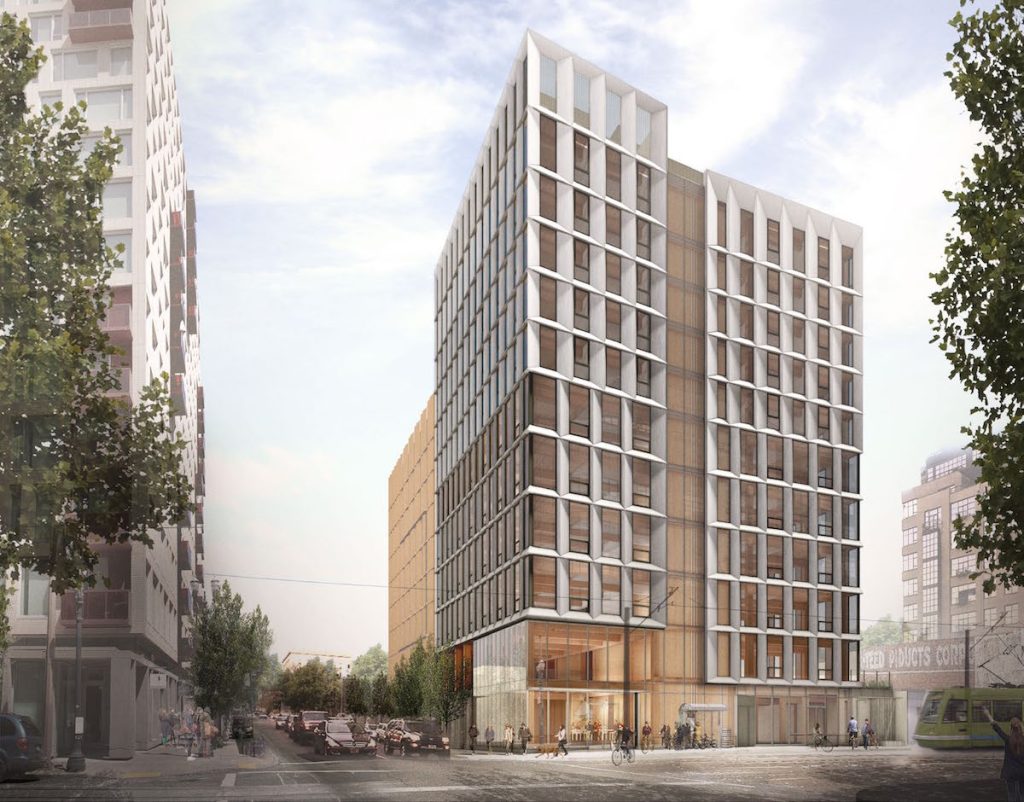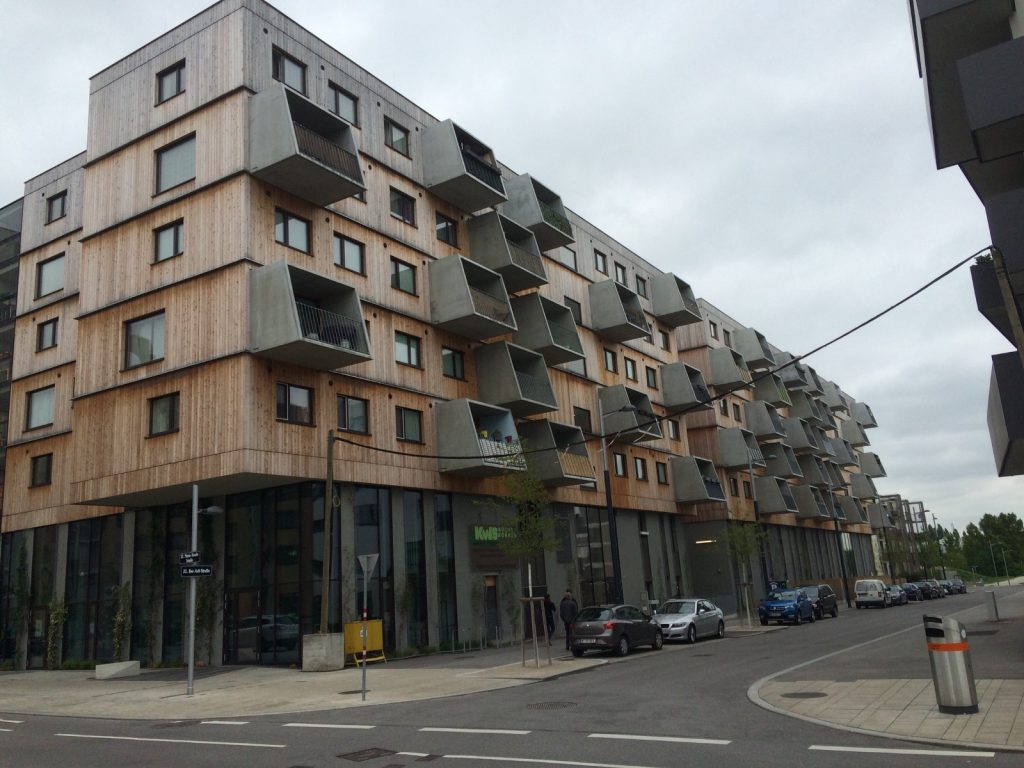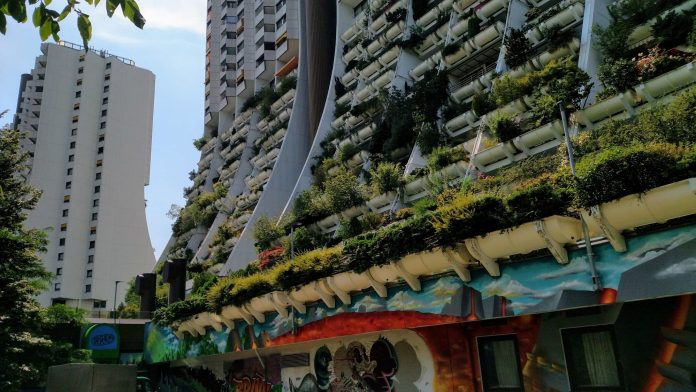We are facing the twin crises of housing affordability and climate change, but solutions at the state level appear too timid while the federal government is coated in Orange Cheeto fingerprints right now and is trying to go backwards. King County decisively backed the I-1631 Climate Pollution Fee in 2018 with 57.7% of the vote, but unfortunately that wasn’t enough to carry a state dominated by other more climate skeptical counties.
State Senator Steve Hobbs proceeded to propose a smaller carbon fee to funnel money into a slush fund for highway pork barrel projects. Misguided as it was, Senator Hobbs demonstrated a willingness to raise significant revenue for new infrastructure. What if our state spent those billions on social housing instead of gratuitous highway interchanges? After all, 350 Seattle has argued that housing action and climate action are one. Investing in deep green housing on a massive scale would bring down the state’s carbon footprint.
Thursday morning State Rep. Nicole Macri announced a package of housing bills aimed at tackling the crisis. Rep. Macri is a real leader on this issue and her policy prescriptions, like expanding the state housing trust fund and rezoning low-density urban areas, would be a big help. However, I think a tectonic shift is in order to grapple with the scale of the problem and get beyond treading water as housing prices continue to climb as median wages stagnate in comparison.
President Ronald Reagan eviscerating public housing in the 1980s marked a turning away from social housing. He switched the funding model to private-public partnerships and the low-income housing tax credit, and public housing has floundered and shrunk since then. We need to reinvest in social housing to overcome four decades of underinvestment and callous disregard.
Washington State 100,000 Homes Initiative
Paris recently made news completing its 100,000th social housing unit since launching a building campaign in 2001. If Paris can do it, Washington State should be able to build 100,000 social housing units in the next decade too.
The need is great. Eight percent of students in Washington state are homeless–more than 40,000 kids! What if we guaranteed a home for every kid in our state? Is that so much to ask in a state as wealthy as ours? Maybe climate messages aren’t as persuasive statewide, but ‘House Every Kid in Washington’ would be a convincing pitch. 100,000 new social homes would be enough to house every homeless student and their family, and we would make a huge dent in housing insecurity and homelessness across the board.
Interestingly the $16 billion that Senator Hobbs plans to spend mostly on highway trinkets appears to be enough to build 100,000 homes if leveraged two times over and built in a smart and dense way. One way to build smart is to take advantage local resources and deep green building techniques by investing in mass timber construction, such as cross-laminated timber. Recently, Washington State changed its building code to make 18-story mass timber buildings legal; so the time is ripe. Building this way would stimulate the state’s sustainable forestry industry, spreading the economic benefits of a booming Seattle to every corner of the state.

We have an opportunity to jumpstart the mass timber industry, but the private development community is conservative and not likely to take the leap without demonstrated success. Setting up a a cross-laminated timber factory requires sufficient demand to justify it; we have to get over that hurdle. A requirement to build at least a quarter of those 100,000 homes with cross-laminated timber would provide the surety to open a cross-laminated timber plant in the state, speeding up adoption in the private homebuilding industry, too.
A sustainably harvested mass timber building spree also has the potential to trap a lot of carbon in our buildings where it can do us the great service of keeping people warm when they want to be, rather when they don’t (i.e, from global warming).
King County Option
I-1631’s popularity in King County presents an opportunity to break free of the climate skeptics and implement a climate investment package at the county level. A state solution offers the widest benefit in response to an affordability crisis that reaches far beyond Seattle. People are suffering from high housing costs and homelessness all across the state, and it’s compounded by another crisis, student debt, that is leaving a generation behind.
To close the housing gap, King County needs about 44,000 homes affordable to lower income households. King County should rise to the occasion of this housing affordability crisis and invest the resources necessary to build 50,000 affordable homes in 10 to 20 years. King is a county that invested $232 million in a new youth jail and forked over $135 million for a stadium slush fund to appease the Seattle Mariners. Surely we’re not that hard up for cash. Plus, spending money to house people before they are in crisis actually saves money over the alternative: relying on expensive emergency services and policing to deal with the repercussions of the gaps in our social safety net, as Downtown Emergency Service Center research has shown.
A ‘Build 50,000 Affordable Homes Climate Action’ platform would likely be popular and link two pressing issues in an elegant way. We can lower our carbon footprint and stimulate the green building industry by building the 50,000 homes to a super-green Passive House standard.

50,000 is a big number, but, because there are about one million homes in King County, it still would only represent about 5% of the county’s housing stock. By comparison, social housing is about 60% of Vienna’s and 82% of Singapore’s housing stock. In Paris, it’s 20%, with a goal of 30% by 2030.
50,000 new social housing units in King County would bring a welcome balance to a supercharged housing market, providing something for everyone. 10,000 homes could be senior housing, helping elders stay in communities where they have friends and support networks even as housing prices have grown beyond the generally more fixed incomes retirement brings. 10,000 homes could be student housing, helping to lower the skyrocketing cost of a college education that is driving many young people into massive amounts of debt. At some community colleges, homelessness rates among students are at double digits. This is no way to run a society.
The Seattle Option
But what if King County isn’t having any of it? Seattle needs to build social housing on a grand scale. A ballot measure to build 10,000 homes in a decade approaches the scale needed, when paired with existing investments. We just authorized a $1.7 billion publicly-financed convention center expansion, hoping to boost corporations and hoteliers and get a nice public benefits package in the process; we can spend that much funding on social housing to boost our people.
Our economy would benefit, too. One of the biggest challenges businesses face right now is finding workers and retaining them, given skyhigh housing costs. A 10,000 homes initiative would be a statement that the working class have a place in Seattle forever.
To date, the Seattle Office of Housing boasts of having funded 12,000 affordable homes. The 10,000 homes measure would nearly double this number, marking a significant impact especially when paired with investments from Mandatory Housing Affordability investments and the ongoing Housing Levy.
Mayor Durkan bragged of 4,000 affordable homes in the pipeline last month. While admirable, this isn’t nearly enough to close the housing gap. Every district in Seattle deserves to have a major social housing development. Moreover, the government owns land that could host social housing across the city. Here’s some possible sites:
- District 1 – West Seattle Golf Course;
- District 2 – Lowe’s in Mount Baker;
- District 3 – Central District;
- District 4 – U District lid;
- District 5 – Jackson Park;
- District 6 – Ballard Station area development; and
- District 7 – Lids in Interbay and Downtown.

Since some of the sites are quite large, it provides the chance to make bold plans. How about Barcelona superblocks to make interior streets car-free so they make great places for kids to play and people to walk, roll, bike, and mosey carefree. Councilmember Teresa Mosqueda proposed implementing these pedestrianized superblocks during her campaign, and she pushed for using public land for social housing, too. The new housing developments don’t have to be completely car-free, but parking could be consolidated on the edge of the complex with access to the exterior, freeing up the interior streets for people. Plus, with these developments being oriented toward high-quality transit, not much parking will be needed.
Why Social Housing: Freeing Housing from Mega Developer Preferences
Upzones are an important part of the housing solution. But on their own, upzones aren’t sufficient to tackle affordability. Recent research by Yonah Freemark underscored this point.
Freemark published a paper based on a natural experiment in Chicago comparing neighborhoods that were upzoned with those that were not. Surprisingly, he could not detect an increase in new housing construction within five years, but housing prices did spike. Here’s Freemark’s abstract:
What are the local-level impacts of zoning change? I study recent
Yonah Freemark – “Upzoning Chicago: Impacts of a Zoning Reform on Property Values and Housing Construction”
Chicago upzonings that increased allowed densities and reduced parking requirements in a manner exogenous of development plans and neighborhood characteristics. To evaluate outcomes, I use difference-in-differences tests on property transaction prices and housing-unit construction permits. I detect significant, robust increases in values for transactions on parcels that received a boost in allowed building size. I also identify value increases for residential condominiums, indicating that upzoning increased prices of existing housing units. I find no impacts of the reforms, however, on the number of newly permitted dwellings over five years. As such, I demonstrate that the short-term, local-level impacts of upzoning are higher property prices but no additional new housing construction.
Whether Freemark’s findings have external validity (and apply in Seattle’s case or when inclusionary zoning is in force) probably requires more research, they do suggest more emphasis is needed on social housing to fill in gaps that the private market cannot.
If you hate developers, but still want density, you need social housing. The reality is a 500-home tower is going to cost $100 million or more. Only giant corporations like Vulcan are going to be able to deal with financing packages that large. That is, unless you’re the government.
Doug Trumm is publisher of The Urbanist. An Urbanist writer since 2015, he dreams of pedestrian streets, bus lanes, and a mass-timber building spree to end our housing crisis. He graduated from the Evans School of Public Policy and Governance at the University of Washington in 2019. He lives in Seattle's Fremont neighborhood and loves to explore the city by foot and by bike.


